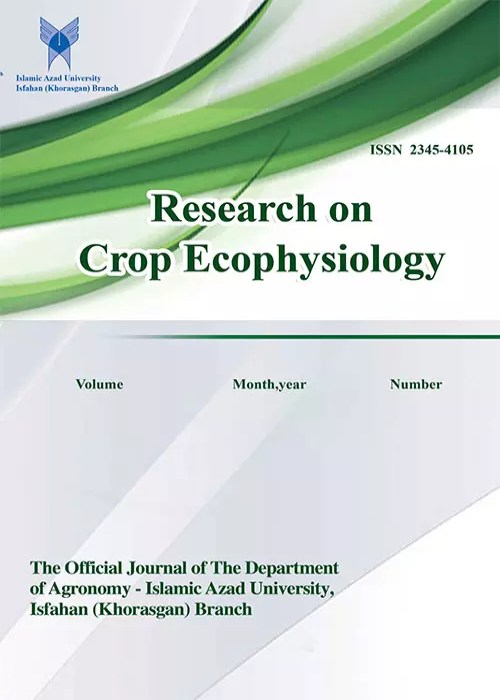Effects of Acidified Irrigation Water and Iron Fertilizers on Shoot Dry Yield, Iron Uptake and Photochemical Efficiency of Corn
Author(s):
Abstract:
Expansion and economical importance of yield reduction due to iron deficiency chlorosis in the world has attracted many researchers attention. Different materials, such as iron sulfate, acidified remediation, wastes, by-products of industries, iron chelate and organic compounds, have been tested to correct iron chlorosis. This experiment studied effect of applying an iron fertilizer for corn (SC 704) consisting sulfur and Thiobacillus bacteria. Experiment was carried out in greenhouse in factorial with complete of randomized design in four replications. The first factor was two kinds of irrigation water, w1= irrigation with ordinary water of soil and water research station of Karaj and w2= irrigation with acidified water of station with pH of 5-5.2 (acidified with sulfuric acid). The second factor was seven iron fertilizer treatments, T1=Control (without iron fertilizer); T2= Iron sequestrine 138 (10 mg. kg-1), T3= Iron sulfate (110 mg.kg-1), T4= Iron oxide powder of iron ore (220 mg.kg-1), T5= T4 + sulfur (250 mg.kg-1 powdered sulfur) + Thiobacillus inoculant (104 cell.gr soil -1), T6= T5 + organic matter, T7= T3 + organic matter. Nitrogen, potassium, triple superphosphate, Mn, Zn, Cu sulfates and acid boric was used 200, 85, 90, 10, 5, 10 and 5 mg. kg-1, respectively. In the end of experiment, Dry shoot and root weight, iron uptake, chlorophyll Index (SPAD 502) and Fv/Fm were measured. Based on results, acidified irrigation water had significant effect on shoot dry weight and P and Fe uptake at five percent probability level, but had no significant effect on chlorophyll index. Effects of different fertilizer treatments on dry weight, P and Fe uptake and chlorophyll index, against Fv/Fm, were significant on five percent level. T6 and T7 produced highest shoot dry weight and T2 produced the lowest. The highest amount of P and Fe uptake was belonging to T7 and the lowest was belonging to T2. The highest amount of chlorophyll index was belonging to T6. Between treatments there was no significant difference on Fv/Fm factor.
Keywords:
Iron sources , Corn , Uptake , Acidified water , Chlorophyll , Fv , Fm
Language:
English
Published:
Journal of Research on Crop Ecophysiology, Volume:7 Issue: 2, 2012
Page:
151
magiran.com/p966829
دانلود و مطالعه متن این مقاله با یکی از روشهای زیر امکان پذیر است:
اشتراک شخصی
با عضویت و پرداخت آنلاین حق اشتراک یکساله به مبلغ 1,390,000ريال میتوانید 70 عنوان مطلب دانلود کنید!
اشتراک سازمانی
به کتابخانه دانشگاه یا محل کار خود پیشنهاد کنید تا اشتراک سازمانی این پایگاه را برای دسترسی نامحدود همه کاربران به متن مطالب تهیه نمایند!
توجه!
- حق عضویت دریافتی صرف حمایت از نشریات عضو و نگهداری، تکمیل و توسعه مگیران میشود.
- پرداخت حق اشتراک و دانلود مقالات اجازه بازنشر آن در سایر رسانههای چاپی و دیجیتال را به کاربر نمیدهد.
In order to view content subscription is required
Personal subscription
Subscribe magiran.com for 70 € euros via PayPal and download 70 articles during a year.
Organization subscription
Please contact us to subscribe your university or library for unlimited access!


